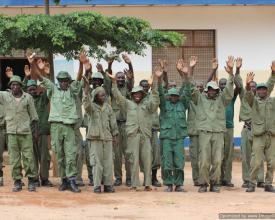Implication des communautés locales dans les patrouilles anti-braconnage

Le projet Ruvuma Elephant s'attaque au déclin dramatique du nombre d'éléphants dû au braconnage dans une zone de 2,5 millions d'hectares comprenant le corridor de faune et de flore sauvages Selous-Niassa, du côté tanzanien de la frontière. Il reconnaît les causes socio-économiques du braconnage tout en augmentant la capacité de patrouille, en impliquant les communautés locales dans la gestion des aires protégées. Les activités comprennent des équipes de patrouille communes, des incitations financières, l'éducation et la formation.
Contexte
Défis à relever
Emplacement
Impacts
- Depuis le lancement du projet, les résultats mesurables sont les suivants : la saisie de 2 181 collets, de 17 037 pièces de bois illégales et de 191 défenses d'éléphants, ainsi que de 836 armes à feu ; Les interventions mises en œuvre comprennent la fourniture d'une assistance directe aux agriculteurs locaux pour la protection des moyens de subsistance (par exemple, l'atténuation des conflits entre l'homme et l'éléphant), le soutien des activités génératrices de revenus pour les communautés de la zone de gestion de la faune sauvage (telles que la culture du piment et l'apiculture), Plus de 85 % des arrestations et des saisies d'armes illégales et d'ivoire ont été réalisées grâce à la collaboration des membres des communautés locales et aux informations qu'ils ont fournies. La plupart des arrestations ont eu lieu en dehors des zones protégées et ont été effectuées avant que d'autres abattages illégaux d'animaux sauvages n'aient lieu dans la zone REP. Le nombre de personnes arrêtées sur le terrain lors de patrouilles de routine a considérablement diminué par rapport à la première année du projet, tout comme la découverte de carcasses et d'ivoire.
